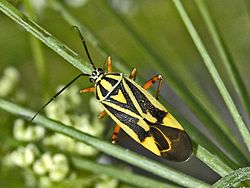| Brachycoleus decolor | |
|---|---|
 | |
| Brachycoleus decolor | |
| Scientific classification | |
| Kingdom: | Animalia |
| Phylum: | Arthropoda |
| Class: | Insecta |
| Order: | Hemiptera |
| Suborder: | Heteroptera |
| Family: | Miridae |
| Genus: | Brachycoleus |
| Species: | B. decolor |
| Binomial name | |
| Brachycoleus decolor Reuter, 1887 | |
| Synonyms | |
| |
Brachycoleus decolor is a species of plant-feeding insects of the family Miridae. [1] [2]